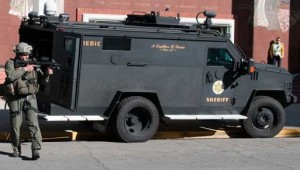An MRAP switcheroo for Albuquerque police?

MAKING A CHANGE: The Albuquerque Police Department has applied for a $350,000 grant acquire an armored tactical vehicle called the MedCat.
By Rob Nikolewski │ New Mexico Watchdog
Last week, the Albuquerque Police Department announced it was getting rid of its massive 45,000-pound Mine-Resistant Ambush Protected vehicle largely due to concerns over criticism about over-militarization.
But now, APD has disclosed it has already purchased one tactical vehicle and plans on obtaining another.
“There’s a lot of sensitivity about using a military vehicle and we understand those concerns and that’s why we’ve gone into the civilian market,” said Janet Blair, Albuquerque Police Department communications and community outreach director.
Over the weekend, APD told the Albuquerque Journal the department spent $240,000 two weeks ago to buy a bullet-proof skid loader called The Rook that APD will use in situations involving barricaded subjects and bomb threats.
In addition, APD is applying for a $350,000 grant to obtain what’s called a MedCat, an armored vehicle similar to an MRAP that carries medical equipment and will be used to transport SWAT team members. On Monday morning, Blair said she wasn’t sure from where the grant money is coming.
“I think (the MedCat and The Rook) are a much better fit for police,” Albuquerque Chief Administrative Officer Rob Perry said in the Journal article.
ON BOARD: While the Albuquerque Police Department will return its MRAP, it has already spent $240,000 on a bullet-proof skid loader called the Rook.
Is the decision to get rid of the MRAP, only to replace it with two other tactical vehicles, just administrative sleight of hand?
“These are civilian vehicles,” Blair said Monday morning. “Armored? Yes, they’re armored for civilian police use.”
Albuquerque resident Linda Klauschie doesn’t see much difference.
“I think they are focusing on the wrong things,” Klauschie told New Mexico Watchdog. “The more aggressive the police approach, the more likely that the person they’re after is going to aggressive. People react to aggression with aggression.”
APD has been the focus of a series of protests, triggered by the shooting death of a homeless man in March. Since 2010, Albuquerque police have shot and killed 27 people, and the U.S. Justice Department issued a report saying APD has a pattern of using excessive force.
Blair said Monday yet another tactical vehicle at APD’s disposal called the BearCat, which dates back to the 1970s, is being overhauled. Once that’s completed, the MRAP will be taken out of commission.
MRAPs have been used by the U.S. military in places such as Iraq and Afghanistan. But with U.S. involvement in those war zones winding down, the Department of Defense is offering the mammoth vehicles to local police entities through the federal government’s 1033 program that oversees the dispersal of excess military equipment.
That’s led some critics to question whether local police forces are going overboard.
“There’s a blurring of the military mission and the civilian police mission and that is a dangerous thing,” Tim Lynch, director of the Project on Criminal Justice at the Cato Institute, a think tank based in Washington, D.C., told New Mexico Watchdog last week. “We want our civilian police departments not to lose sight of the fact that they are dealing with people on a day-to-day basis with constitutional rights, and we want them to use a minimum amount of force to bring suspects into a court of law.”
New Mexico police chiefs who have obtained MRAPs say the vehicles are useful.
“Being down here in a desert area, along the border, we have a lot of remote areas,” said Brandon Gigante, the chief of police in Deming, population 14,793. “We can offer assistance to agencies like the Border Patrol and help move people out, evacuate or rescue (people) out in the desert (who may be) dehydrated.”
According to records obtained by New Mexico Watchdog, 18 police entities in the state have acquired MRAPs, including the campus police department at New Mexico State University.
Contact Rob Nikolewski at rnikolewski@watchdog.org and follow him on Twitter @robnikolewski







